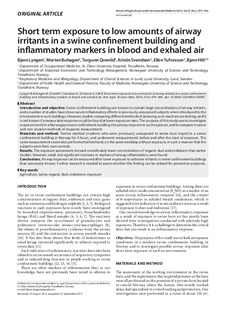| dc.contributor.author | Lyngen, Bjørn Arnt | |
| dc.contributor.author | Buhagen, Morten | |
| dc.contributor.author | Qvenild, Torgunn | |
| dc.contributor.author | Svendsen, Kristin V Hirsch | |
| dc.contributor.author | Tufvesson, Ellen | |
| dc.contributor.author | Hilt, Bjørn | |
| dc.date.accessioned | 2019-11-08T08:14:19Z | |
| dc.date.available | 2019-11-08T08:14:19Z | |
| dc.date.created | 2014-09-29T08:36:12Z | |
| dc.date.issued | 2014 | |
| dc.identifier.citation | AAEM: Annals of Agricultural and Environmental Medicine. 2014, 21 (3), 479-484. | nb_NO |
| dc.identifier.issn | 1232-1966 | |
| dc.identifier.uri | http://hdl.handle.net/11250/2627303 | |
| dc.description.abstract | Introduction and objective. Swine confinement buildings are known to contain large concentrations of airway irritants, and a number of studies have shown acute inflammatory effects in previously unexposed subjects when introduced to the environment in such buildings. However, studies comparing different methods of assessing such reactions are lacking, and it is not known if a measurable response could be found at lower exposure rates. The purpose of this study was to investigate exposure levels in a Norwegian swine confinement building, the airway response to such exposure, and to compare invasive and non-invasive methods of response measurement. Materials and method. Twelve medical students who were previously unexposed to swine dust stayed in a swine confinement building in Norway for 4 hours, and underwent measurements before and after the start of exposure. The same measurements were also performed beforehand, on the same weekday without exposure, in such a manner that the subjects were their own controls. Results. The exposure assessment showed considerably lower concentrations of organic dust and endotoxin than earlier studies. However, small, but significant increases in markers of airway inflammation, were found. Conclusions. Airway response can be measured after lower exposure to airborne irritants in swine confinement buildings than previously known. Further research is needed to assess whether this finding can be utilized for preventive purposes. | nb_NO |
| dc.language.iso | eng | nb_NO |
| dc.publisher | Institute of Rural Health | nb_NO |
| dc.rights | Navngivelse-Ikkekommersiell 4.0 Internasjonal | * |
| dc.rights.uri | http://creativecommons.org/licenses/by-nc/4.0/deed.no | * |
| dc.title | Short term exposure to low amounts of airway irritants in a swine confinement building and inflammatory markers in blood and exhaled air | nb_NO |
| dc.type | Journal article | nb_NO |
| dc.type | Peer reviewed | nb_NO |
| dc.description.version | publishedVersion | nb_NO |
| dc.source.pagenumber | 479-484 | nb_NO |
| dc.source.volume | 21 | nb_NO |
| dc.source.journal | AAEM: Annals of Agricultural and Environmental Medicine | nb_NO |
| dc.source.issue | 3 | nb_NO |
| dc.identifier.doi | 10.5604/12321966.1120587 | |
| dc.identifier.cristin | 1159070 | |
| dc.description.localcode | Under a (CC BY-NC) license. | nb_NO |
| cristin.unitcode | 1920,8,0,0 | |
| cristin.unitcode | 194,60,25,0 | |
| cristin.unitcode | 194,65,20,0 | |
| cristin.unitname | Klinikk for lunge og arbeidsmedisin | |
| cristin.unitname | Institutt for industriell økonomi og teknologiledelse | |
| cristin.unitname | Institutt for samfunnsmedisin og sykepleie | |
| cristin.ispublished | true | |
| cristin.fulltext | original | |
| cristin.qualitycode | 1 | |

